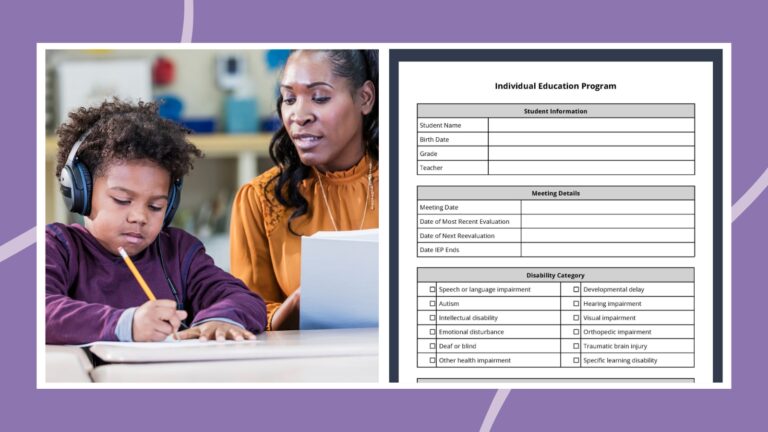There are as many IEP goals as there are students. But the longer you teach special education, the more you’ll find yourself searching for just the right reading comprehension goal for a student with a learning disability or a behavior goal for a kid who has ADHD. That’s where an IEP goal bank, also known as a goal database, comes in.
Below you’ll find a list of over 100 IEP goals covering a variety of focus areas. Plus be sure to fill out the form on this page to get access to a free, editable Google Doc version of the goal bank along with a bundle of free editable goal-tracking sheets. The bundle includes daily and weekly goal-tracking sheets, as well as trial tracking and progress tracking sheets for data collection.
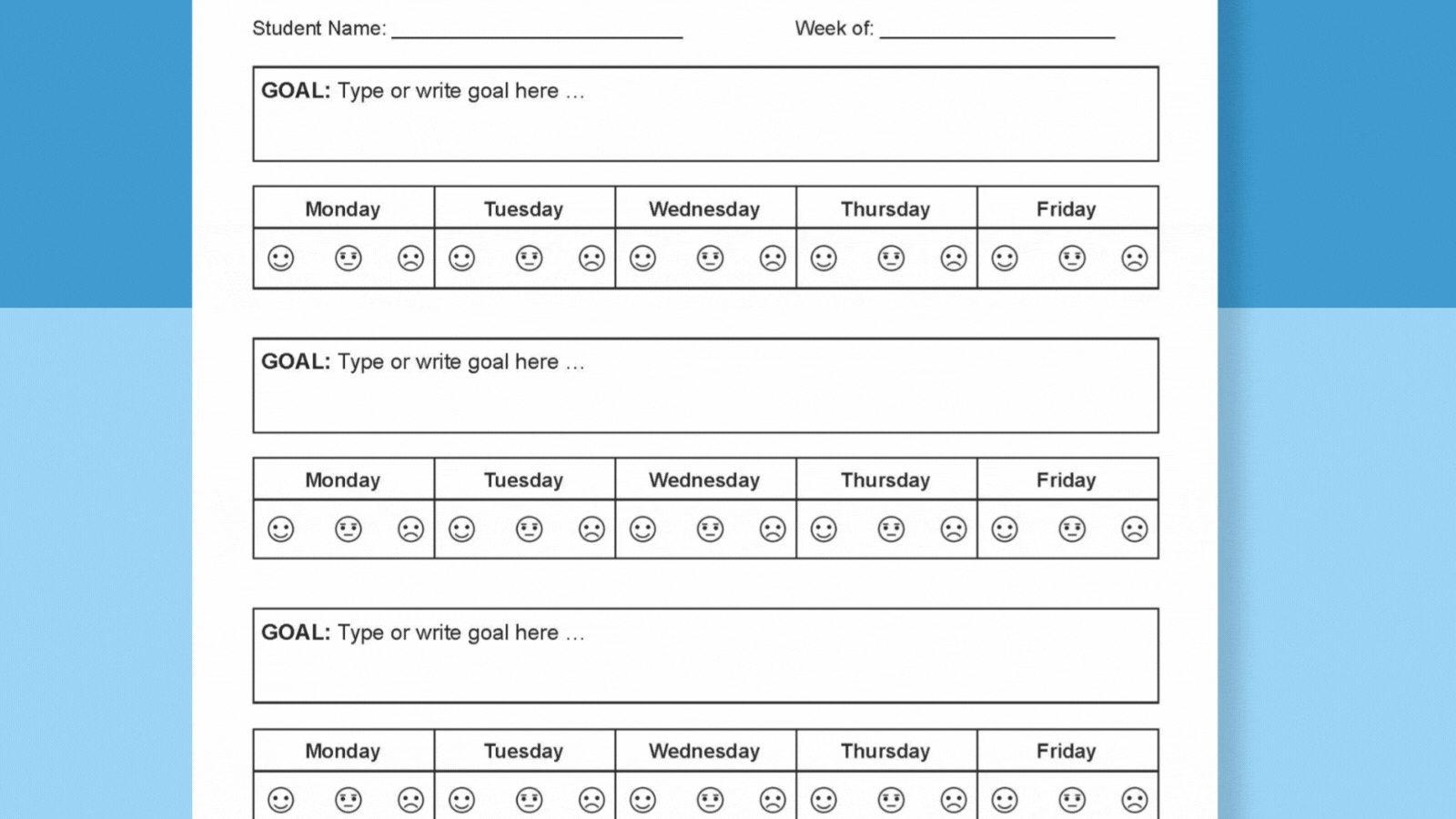
Jump to:
- IEP Goals 101
- Reading Comprehension Goal Bank
- Math Goal Bank
- Writing Goal Bank
- Behavior Goal Bank
- Social Skills Goal Bank
- Social-Emotional Goal Bank
- Executive Functioning Goal Bank
- Self-Advocacy Goal Bank
IEP Goals 101
IEP goals should be specific enough to be implemented by anyone who reads them. They should address aspects of the general curriculum but at the student’s functional level. And the goals should be actionable and measurable.
The goals should also include the accuracy and number of trials that the student needs to complete to show mastery. The accuracy and number of trials will depend on the student’s ability, strengths, and skills. (Typical accuracy and trials are 80% 4-out-of-5 trials.)
Finally, the goals should include the level of support the student needs. Should they be demonstrating the skill independently, or do they need a few prompts or maximum support? Build that into the goal too.
So, a finished goal might be: When given a pile of coins (all one type), Jaime will count the coins and find the total with no more than two prompts with 70% accuracy in 3 out of 5 trials.

IEP Goals for Your Database
A lot of thought goes into each IEP goal, so here are more than 100 goals that every special education teacher should have in their bank.
Reading Comprehension IEP Goal Bank
Reading comprehension is a skill that many students struggle with it. Choose a goal that helps students reach the next level of reading comprehension so they can understand and enjoy what they read.
- When given a story at their reading level, [STUDENT] will use a storyboard or story map to outline the story’s main elements.
- When given a nonfiction text at their reading level, [STUDENT] will select and use the appropriate graphic organizer to identify key information.
- When given a paragraph at their reading level, [STUDENT] will apply the RAP strategy (Reading a single paragraph, Asking oneself to define the main idea and supporting details, Putting the information into the reader’s language).
- When given a paragraph at their reading level, [STUDENT] will apply QAR (question-and-answer relationship) strategy to answer questions.

- When given a passage at their reading level, [STUDENT] will use an outline strategy to summarize the content or retell the story.
- When given a text at their reading level, [STUDENT] will read and demonstrate literal knowledge by answering five literal questions.
- [STUDENT] will demonstrate understanding of text using total communication (AAC devices, PECS, verbalization, sign language) to answer five literal questions about the text.
- When presented with a passage at their reading level, [STUDENT] will use context clues to identify the meaning of unknown words.
- When given a passage at their instructional level, [STUDENT] will make a prediction and read to confirm or adjust their prediction with information from the text.
- When given a text at their reading level, [STUDENT] will identify the main idea and two supporting details.
- When [STUDENT] is given pictures and word cards, they will match 15 new functional vocabulary words with pictures.

- Given a sentence, [STUDENT] will combine background knowledge with information from the text to infer the author’s meaning.
- Given a passage at their reading level, [STUDENT] will answer five inferential questions.
- After reading a passage with visual supports (e.g., highlighting), [STUDENT] will answer literal questions with minimal assistance.
- After reading a passage at their reading level, [STUDENT] will identify the author’s purpose for writing.
- Given a list of author’s purposes and a text, [STUDENT] will select the correct author’s purpose for writing.
Math IEP Goal Bank
Students may be working on numeracy or word problems. Whatever their focus, choose a math goal that helps them progress.
- [STUDENT] will identify a one- or two-digit number (verbally, pointing, written).
- [STUDENT] will rote-count from 1 to 25 (or higher).
- [STUDENT] will skip-count by 2, 3, 5, 10 to 50 (verbal or written).
- When given up to 10 objects, [STUDENT] will count and state how many objects there are (verbally, pointing).
![When given up to 10 objects, [STUDENT] will count and state how many objects there are (verbally, pointing).](https://www.weareteachers.com/wp-content/uploads/3-44.jpg)
- Given 10 addition problems, [STUDENT] will independently add single-digit numbers with (or without) regrouping.
- [STUDENT] will independently subtract a single-digit number from a double-digit number with (or without) regrouping.
- Given 10 subtraction problems, [STUDENT] will independently subtract double-digit numbers from double-digit numbers with (or without) regrouping.
- [STUDENT] will independently tell time to the half hour (or quarter hour, etc.) on an analog clock (verbal or written).
- [STUDENT] will independently identify the next dollar amount when given a price, determine how much is needed to make a purchase, and count out the necessary amount using school money.
- Given a quarter, dime, nickel, and penny, [STUDENT] will identify the coin and value.
- Given a random amount of coins (all one type or mixed), [STUDENT] will independently count the coins.
- When given a mix of coins and dollar bills, [STUDENT] will independently count the money.
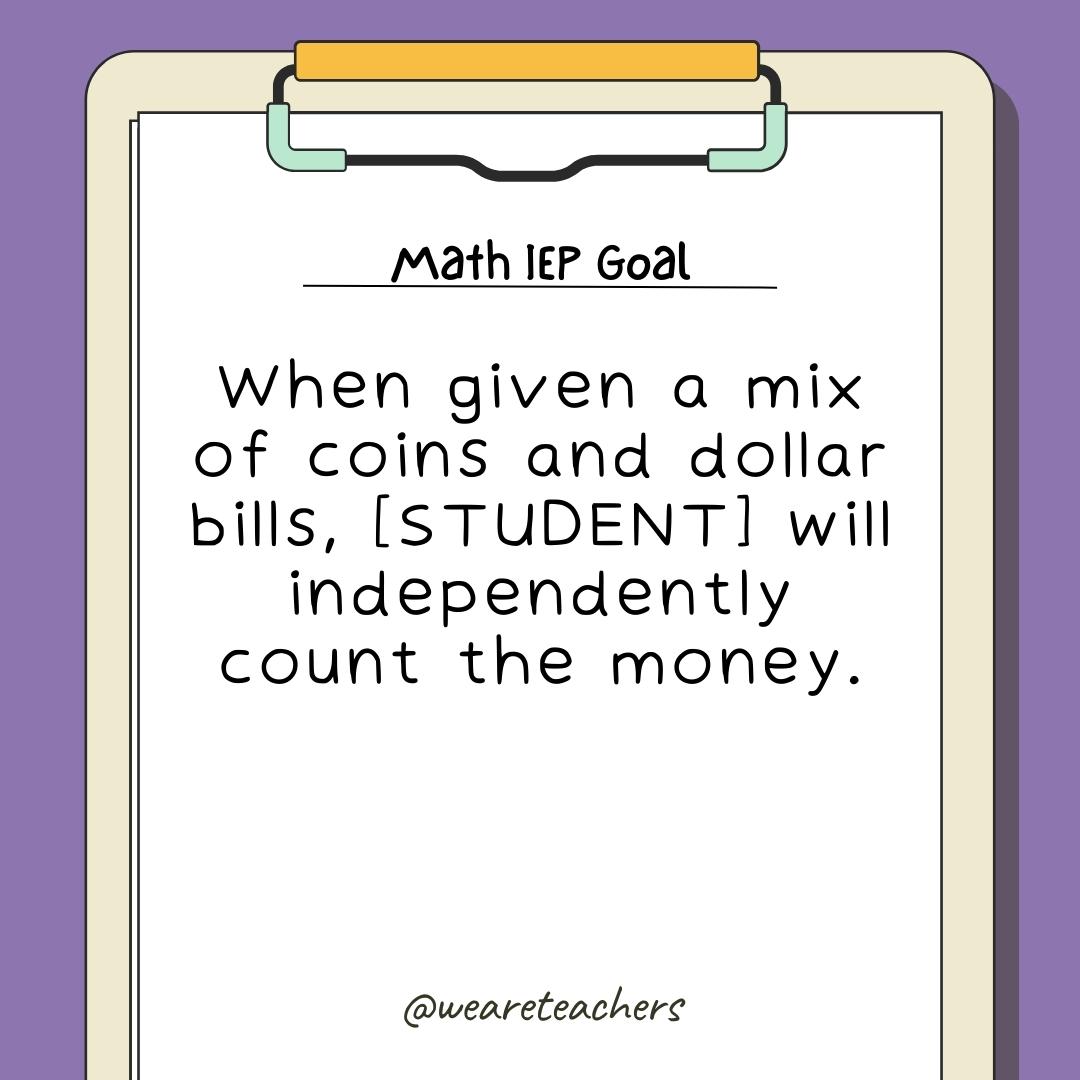
- When given two-digit (or three- or four-digit) numbers, [STUDENT] will round to the nearest tens (or hundreds or thousands).
- Given two numbers (pictures, groups of items), [STUDENT] will determine which number is greater than/less than/equal to by selecting or drawing the appropriate symbol.
- Given data and a graph (bar, pie), [STUDENT] will complete the graph to display the data.
- Given a graph (bar, pie, line), [STUDENT] will answer three questions about the data.
- [STUDENT] will identify the numerator and denominator in a fraction.
- When given a picture of a shape divided into parts, [STUDENT] will color the correct number of sections to represent the fraction given.
- When given five addition problems with fractions, [STUDENT] will add fractions with like denominators.
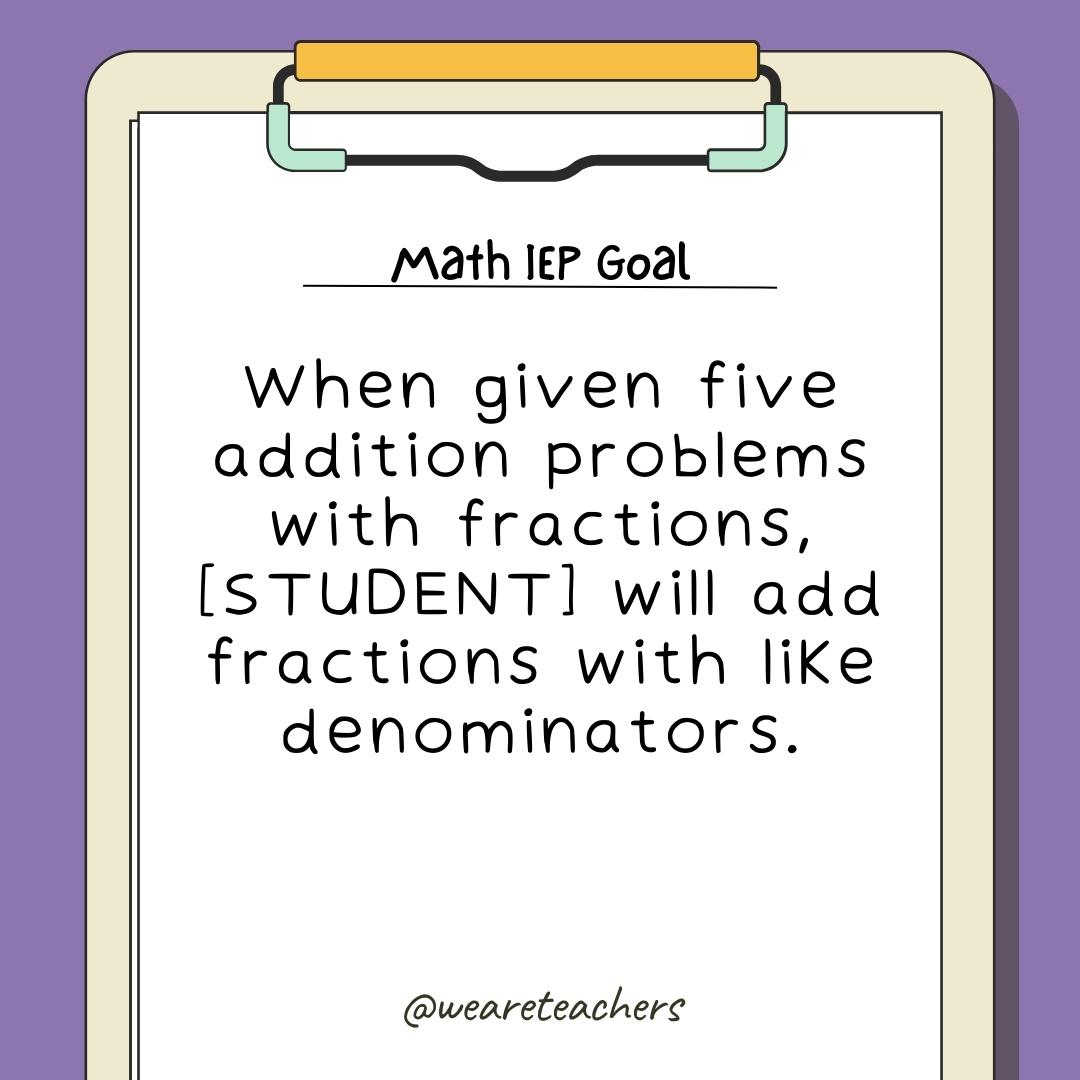
- [STUDENT] will solve one-step word problems using addition and subtraction (or multiplication and division).
- [STUDENT] will independently solve 15 multiplication facts (up to 9).
- Given a fact-fluency tracker, [STUDENT] will track mastery of multiplication facts up to 12.
- Given a problem-solving checklist, [STUDENT] will use the checklist to solve a one-step or two-step word problem.
Writing IEP Goal Bank
Here are writing IEP goals for organization, fluency, and editing.
- Given a topic, [STUDENT] will write a sentence that accurately addresses the topic.
- Given a word bank, [STUDENT] will select the appropriate words to complete a sentence or paragraph about a topic.
- [STUDENT] will use a keyword outline to write a paragraph with at least [number of] sentences, including an introduction/topic sentence and conclusion sentence.
- When given a writing assignment in the general or special education setting, [STUDENT] will apply the use of an editing checklist that includes prompts for grammar, punctuation, capitalization, and full sentences to review and revise a paragraph.

- [STUDENT] will dictate a response to a question and use talk-to-text to communicate at least three sentences about a topic.
- [STUDENT] will write a three-paragraph essay about a topic that includes a clear introductory sentence, main idea, supporting details, and conclusion.
- [STUDENT] will select and use the appropriate graphic organizers to organize ideas in response to a writing topic.
- When given a paragraph to revise, [STUDENT] will edit their writing to organize sentences into paragraphs.
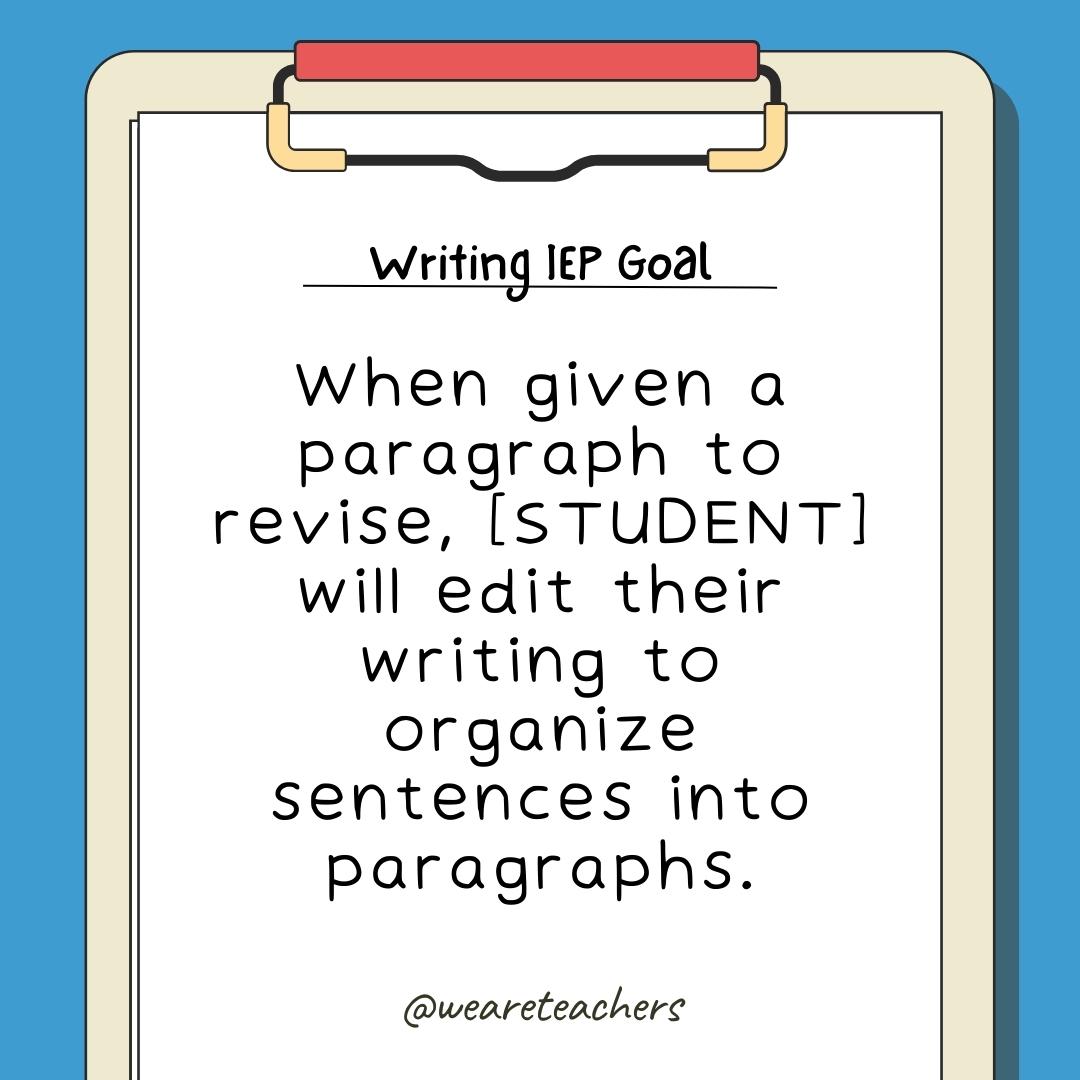
- When given a paragraph to revise, [STUDENT] will add transitional words and phrases to connect ideas in sentences (or paragraphs).
- When given a prompt, [STUDENT] will maintain writing for [amount of time] as measured by observation and student writing output.
Behavior IEP Goal Bank
Everything we see in school is behavior, from working to engaging in class to maintaining self-control and managing emotions. If a student has an IEP for ADHD, an emotional disability, autism, or other categories, they may be working on behavior goals to improve their ability to succeed in school.
- Given a self-monitoring checklist, [STUDENT] will demonstrate self-regulation during [# of sessions] across [# of months].
- Given a task and verbal (written, picture) instructions, [STUDENT] will begin the task within [# of minutes].
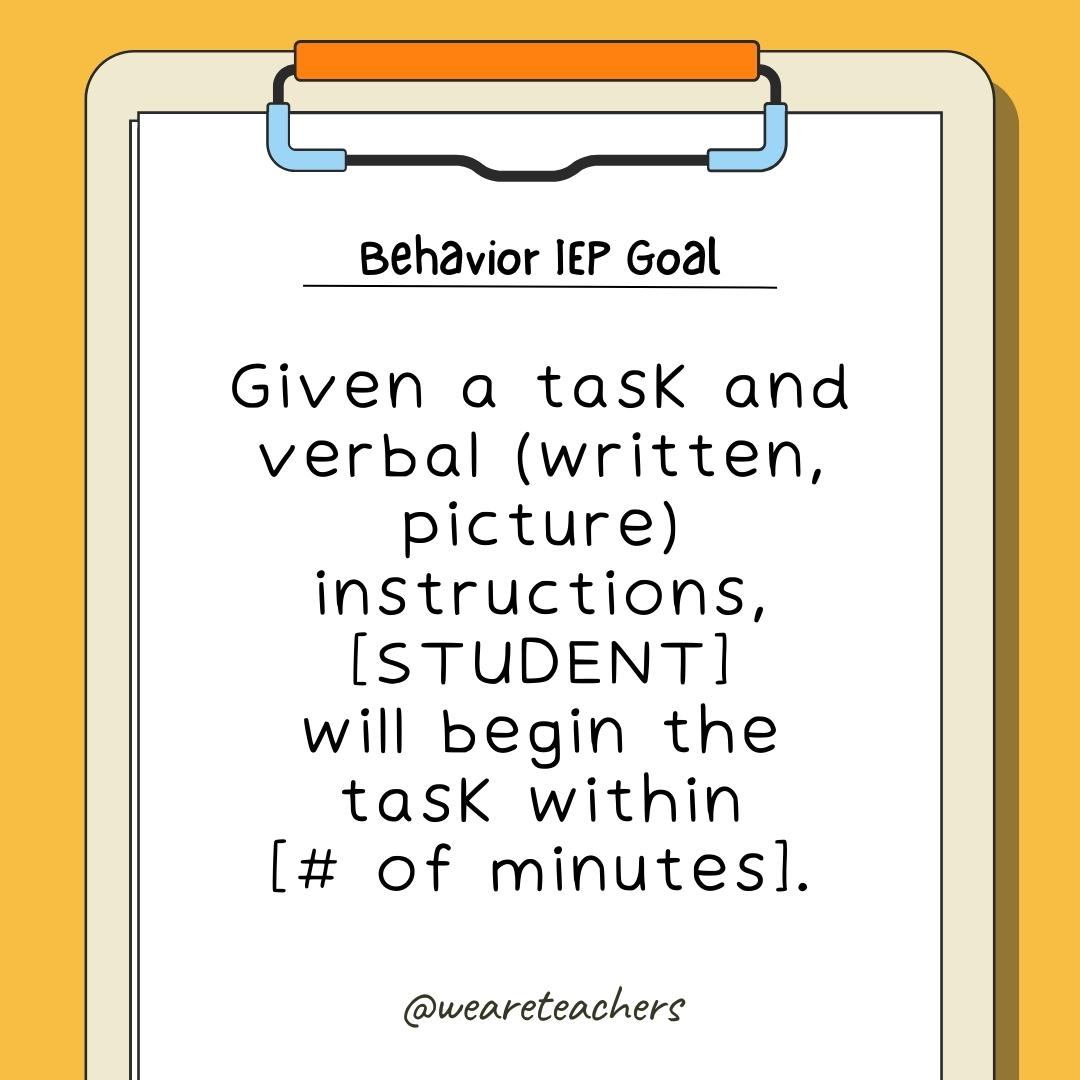
- Given a token board, [STUDENT] will follow class rules to earn [# of tokens] for each 30-minute period in special and general education settings.
- Given a self-regulation strategy (e.g., zones of regulation), [STUDENT] will identify when they are moving from green to red, and apply a self-regulation strategy to maintain their self-regulation.
- Given support and a visual model, [STUDENT] will implement an organizational system for their locker/desk/backpack/binder.
- Given a multi-step assignment, [STUDENT] will break the task into parts and organize the task on paper including steps, materials, and time frame.

- Given scripts and reminders, [STUDENT] will manage frustration and disruptions to their routine during classroom activities.
- Given a social story, [STUDENT] will be able to adjust to new routines and procedures in the classroom.
- By the end of the IEP, [STUDENT] will manage conflicts, independent of teacher support, 4 out of 5 occurrences over a ___ time period.
- Given a work assignment, [STUDENT] will initiate work tasks as measured by observation and work completion.
- Given a work assignment, [STUDENT] will complete work tasks as measured by observation and work completion.
- Given a token board and visual or rules, [STUDENT] will follow rules and earn tokens throughout the total school environment.
Social Skills IEP Goal Bank
Social skills may not seem academic, but how students engage with others can be an important outcome for students who have deficits in this area. Here are goals that can support their progression in forming relationships with peers and adults.
- During unstructured class time, [STUDENT] will engage in respectful conversation with peers (maintain personal space, use respectful voice).
- During unstructured class time or play time (e.g., recess), [STUDENT] will engage with peers (participate, share, follow rules, take turns) for > 10 minutes with minimal adult prompting.
- When given an example of a social conflict, [STUDENT] will identify the problem and brainstorm [# of possible solutions].

- During a preferred activity, [STUDENT] will invite a peer to join in during recess.
- During a preferred activity, [STUDENT] will engage in appropriate conversation (ask appropriate questions, respond to questions, take turns) for > five turns.
- When frustrated or involved in a conflict, [STUDENT] will resolve the conflict without aggression but will apply a problem-solving strategy (walk away, tell a teacher).
- [STUDENT] will demonstrate five back-and-forth exchanges with peers during structured play activities.
- [STUDENT] will recognize the need for and ask to take a break when feeling overwhelmed.
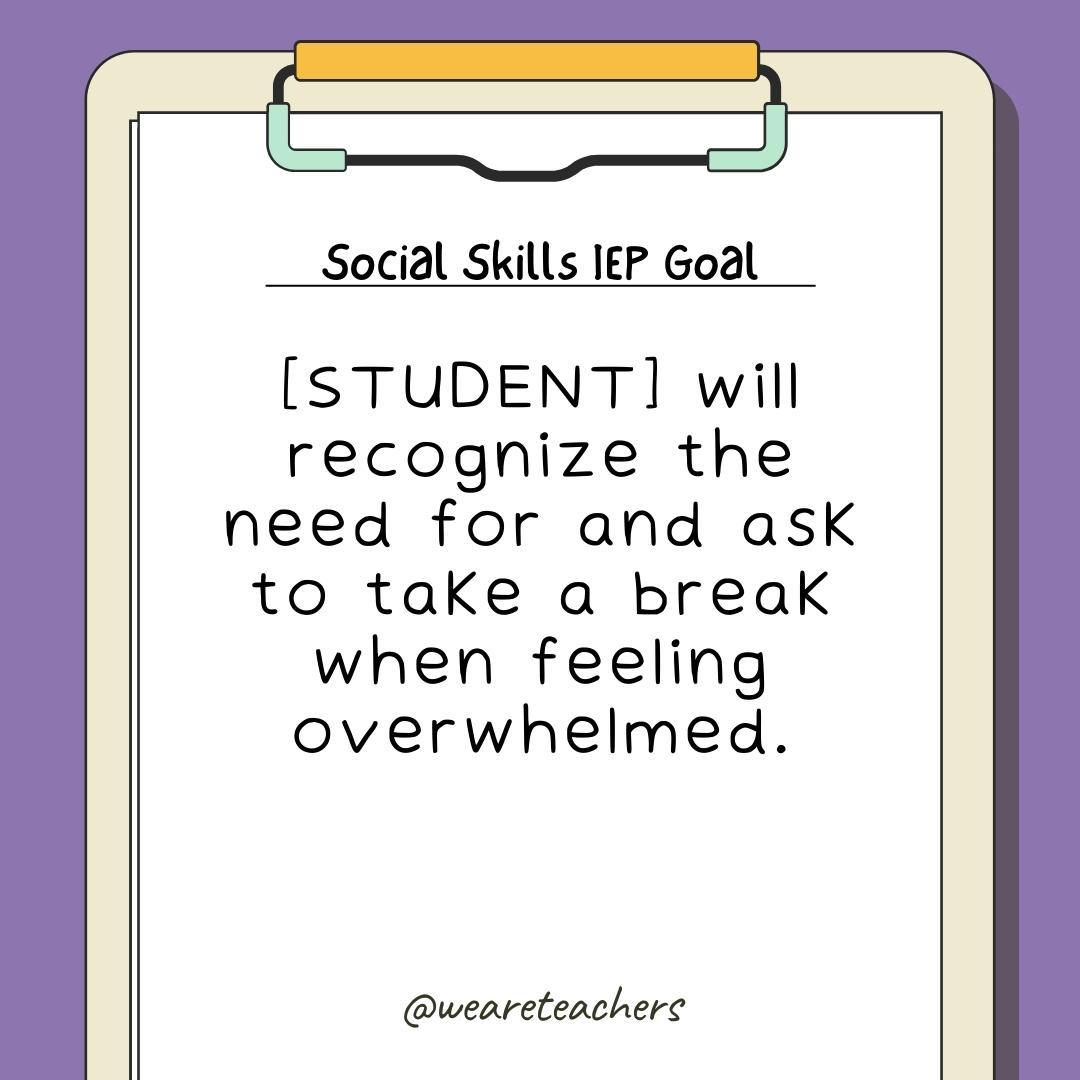
- [STUDENT] will engage in appropriate turn-taking with peers in classroom discussion.
- [STUDENT] will decrease inappropriate verbal comments to once per day (or week) or less as measured by teacher observation and behavior checklist.
- Given a pre-activity checklist, [STUDENT] will identify one peer they would like to engage with and how they are going to engage (e.g., ask a question, invite to play).
Social-Emotional Skills IEP Goal Bank
Identifying and managing feelings is another important school outcome for students who have deficits in this area. Here are goals that help students advance in social-emotional skills.
- [STUDENT] will work cooperatively with peers in small-group settings (e.g., share materials, engage in conversation, accept others’ ideas).
- [STUDENT] will engage in cooperative play interactions by letting others make changes to the play routine.
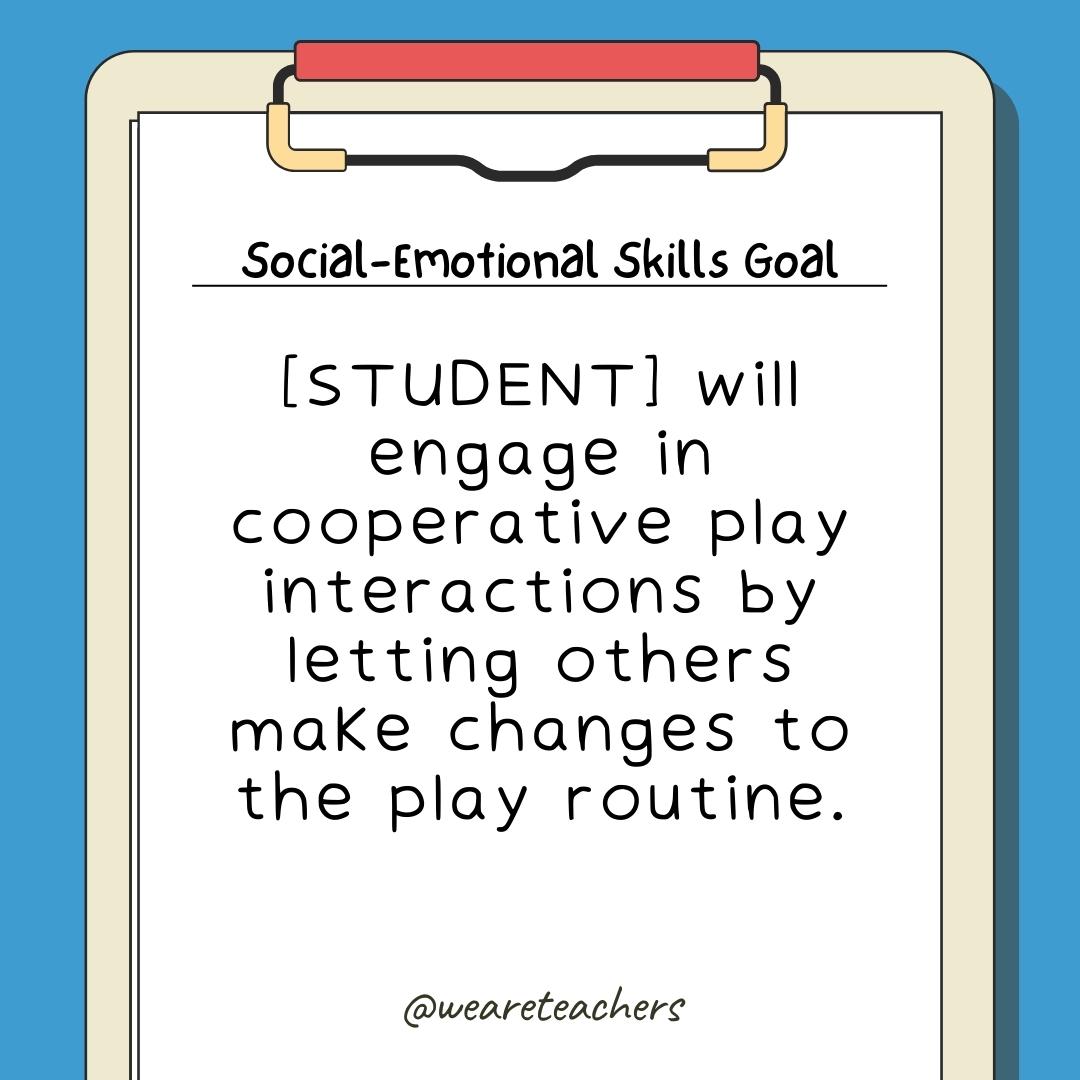
- [STUDENT] will identify appropriate social rules and expectations for various social situations.
- [STUDENT] will refrain from interrupting others.
- [STUDENT] will identify emotions presented in picture form.
- When prompted, [STUDENT] will state their feeling and why they are feeling that way.
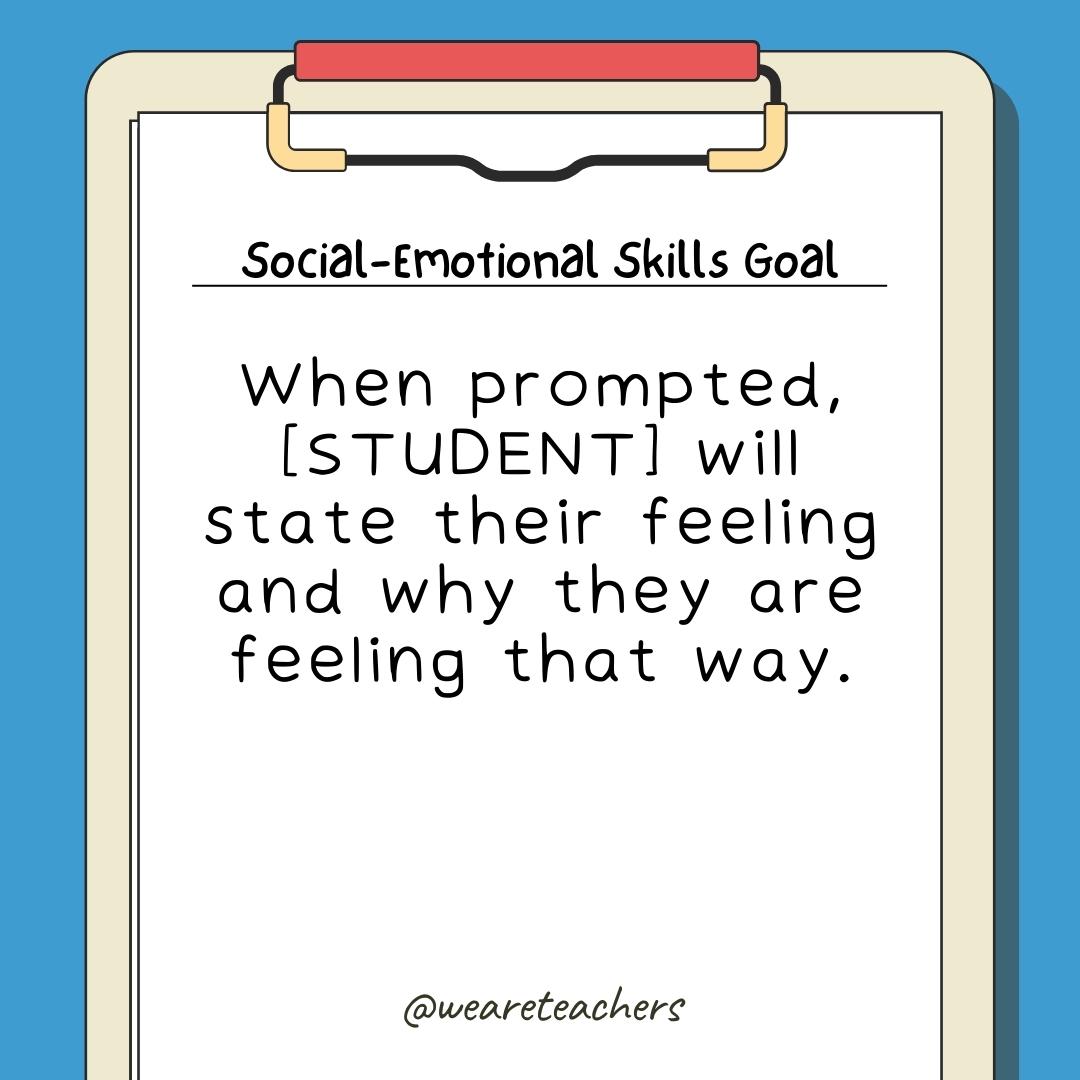
- [STUDENT] will engage in communication with others by asking questions when provided with the opportunities.
- [STUDENT] will increase or maintain conversation about a preferred or nonpreferred topic.
- Given a strategy and visual prompts, [STUDENT] will identify the signs of anxiety and apply a strategy to address feelings of anxiety in real and simulated situations.
- Given a picture scale, [STUDENT] will identify the level of anxiety they are feeling.
Executive Functioning IEP Goal Bank
Executive functioning skills are skills like planning, working memory, attention, problem-solving, mental flexibility, and self-regulation that help kids be successful in school. Students with poor executive functioning have a hard time with time management, organization, getting started with or finishing work, and connecting past experiences with current actions. (Know any kids like this?) Here’s a list of goals for helping students with executive functioning.
- Given visual cues, [STUDENT] will implement a system for organizing their backpack (locker, binder).
- Given a task and a list of materials, [STUDENT] will gather the needed items to complete the task.
- Given an assignment, [STUDENT] will create a plan (to-do list, flow chart) to use to complete the assignment.

- [STUDENT] will arrive at class with necessary materials (paper, pen, computer).
- [STUDENT] will use a checklist (visual schedule) to independently complete classwork.
- [STUDENT] will respond appropriately to oral commands.
- [STUDENT] will ask for clarification and further explanation when needed.
- [STUDENT] will request desired objects or instructional materials and equipment using [picture prompts, sign language, AAC device, etc.].
- [STUDENT] will follow activity schedule and obey rules and regulations that have been discussed and described orally.

- [STUDENT] will express needs, wants, and feelings using [picture prompts, sign language, verbalization, etc.].
- [STUDENT] will create a daily visual schedule (or checklist or to-do list) and complete it.
- By the end of the IEP, [STUDENT] will demonstrate the ability to follow multiple-step directions (two or three steps) with minimal (one or two) adult prompts.
- By the end of the IEP, [STUDENT] will refer to their checklist for task completion to finish assigned work.
Self-Advocacy IEP Goal Bank
Self-advocacy goals are for skills from decision-making to goal attainment, asking for help, and speaking up for yourself. These are important skills that students need to develop, especially as they transition into independent living, college, and career.
- [STUDENT] will effectively communicate their needs and preferences in the classroom by [raising their hand, writing a note].
- [STUDENT] will use a communication notebook to write questions and concerns to the teacher one time per week.
- [STUDENT] will identify a goal, create a list of steps to achieve the goal, and work through the steps.
- Given a challenging situation to solve, [STUDENT] will define the problem and come up with two possible solutions.
- Given a task that involves a choice (e.g., the school lunch menu, a list of books), [STUDENT] will select between the options available.
![IEP-Goal-Bank-16 Given a task that involves a choice (e.g., the school lunch menu, a list of books), [STUDENT] will select between the options available.](https://www.weareteachers.com/wp-content/uploads/IEP-Goal-Bank-16.jpg)
- [STUDENT] will create a list of three personal strengths and three areas for improvement.
- [STUDENT] will actively participate in the development of their IEP goals and accommodations.
- [STUDENT] will identify one IEP goal and three objectives to support that goal.
- When faced with an academic challenge, [STUDENT] will seek assistance by raising their hand or using the classroom procedure for seeking help.
- [STUDENT] will advocate for accommodations and/or modifications in the classroom using an appropriate time, tone of voice, and language.
- [STUDENT] will demonstrate understanding of their learning preferences using a checklist, verbal communication, or another method of communication.
- [STUDENT] will engage in positive self-talk daily with and without teacher support.
- By the end of the IEP, [STUDENT] will learn and apply two self-advocacy strategies.
![IEP-Goal-Bank-17 By the end of the IEP, [STUDENT] will learn and apply two self-advocacy strategies.](https://www.weareteachers.com/wp-content/uploads/IEP-Goal-Bank-17.jpg)
- By the end of the IEP, [STUDENT] will demonstrate the ability to ask for help when needed.
- By the end of the IEP, [STUDENT] will identify and communicate two environmental requirements (e.g., “I need a movement break”).
- By the end of the IEP, [STUDENT] will engage in three conferences and/or meetings where the student will communicate their educational needs.
- [STUDENT] will explain and advocate for testing accommodations through the classroom teacher, testing center, school counselor, etc.
- [STUDENT] will reflect on their academic progress and will determine which accommodations are supporting their learning.
Get Your Free Editable and Printable IEP Goal Bank and Goal Sheets
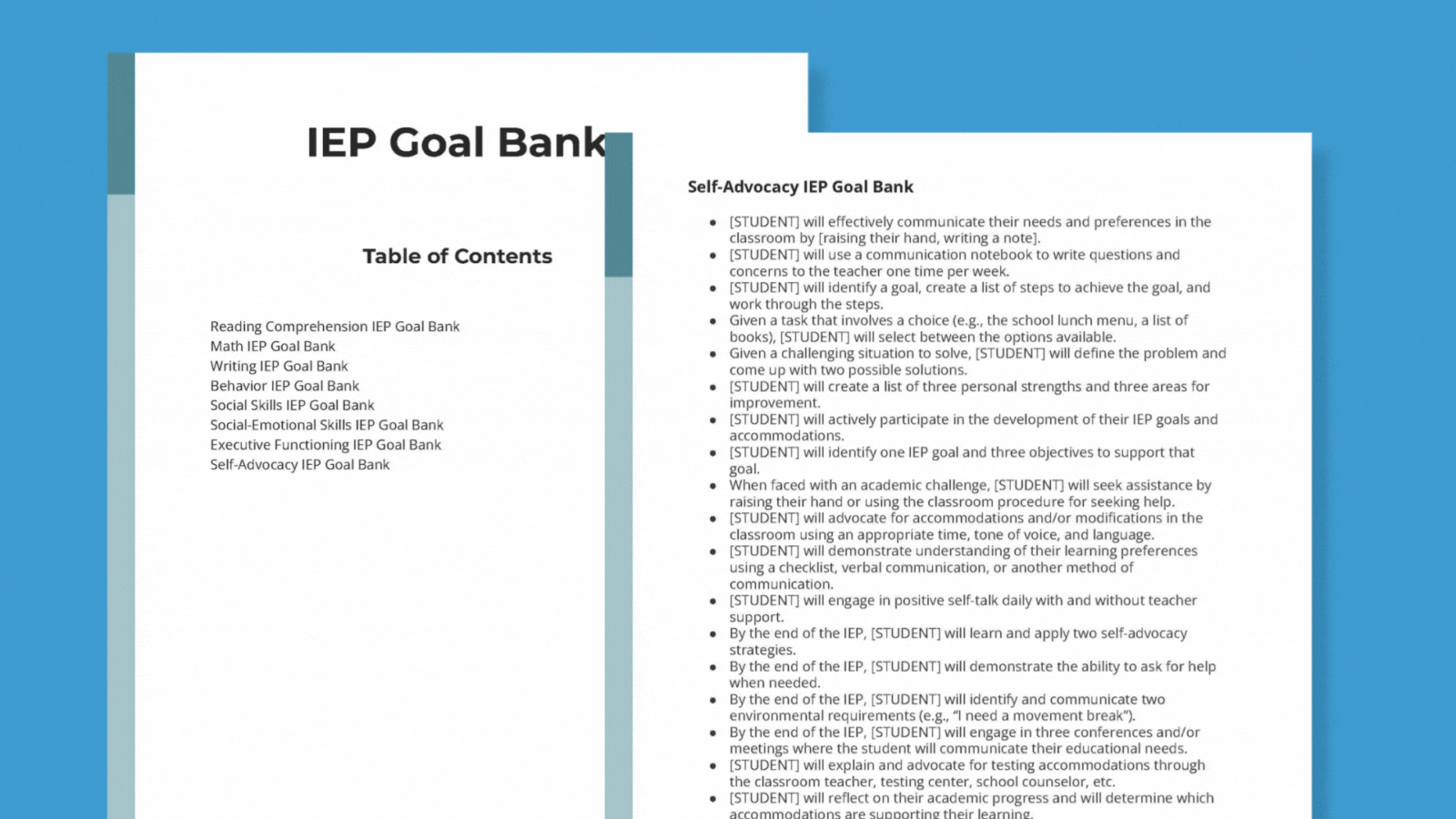
Just fill out the form on this page to get instant access to an editable Google Doc with all the goals mentioned above as well as a bundle of four printable and editable goal-tracking sheets. Save your goal bank and access it any time to cut and paste goals into your IEP software and/or into the editable and printable goal-tracking sheets provided. The bundle includes daily and weekly tracking sheets, as well as trial tracking and progress tracking sheets for data collection.

